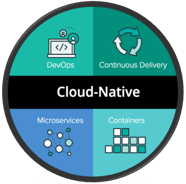Geert Baeke is a cloud architect at the Cronos Group. As a cloud expert, he explains a bit about the new buzzword Cloud Native. What is it, why should companies already be thinking about it, what are the possibilities and how do you get started?
In a nutshell, companies are looking at Cloud Native to provide faster answers to what their external and internal customers are asking of them. It's a way to build applications in dynamic environments in the best way possible.

Cloud Native has the important advantage that you will be using principles that will allow both your development and infrastructure teams to optimally switch in the fast-paced cloud world. For example, this is because Cloud Native's automation and orchestration systems take work out of your hands and take care of it themselves. For every action you have to do twice, you save time by automating it.
But there are not only technical advantages, there is also a lot to gain in the area of culture with Cloud Native. You can give teams enough independence to build and support solutions, and it also ensures that you can easily adjust your strategy when needed.
People quickly think of Microsoft when they think of Cloud Native but companies jumping on the Cloud Native bandwagon will be looking primarily to the Cloud Native Computing Foundation (CNCF) from the Linux Foundation. The CNCF is vendor-neutral and is supported by all the major cloud vendors such as Microsoft and Amazon, but also by smaller unknown players. This creates, as it were, a "Cloud Native community" that donates products and solutions to the CNCF through open source. The CNCF then assigns certain properties to these products, such as what stage of life the product is in. Kubernetes and Prometheus are two examples of CNCF products that are widely used today, and so there are probably still CNCF products that companies use without knowing that they are actually Cloud Native products.

Convinced? So how do you go about getting started with Cloud Native in concrete terms? The important thing to know here is that there is no de facto standard for implementing Cloud Native, there are different paths to Rome. Equally important is to first take a thorough look at your business requirements, as there may be easier solutions to achieve your goal - without Kubernetes, for example. Cloud Native contains some form of complexity and definitely requires a learning curve, which is why it's a good idea to learn to swim first before jumping into the deep end.
Is your IT infrastructure made up of different cloud platforms? Or do you still have some on-prem servers running? Then Azure Arc is the perfect tool for you! It allows you to manage your entire hybrid or multi-cloud environment in the blink of an eye, from one central location. Want to find out
Migrating to the cloud is a big step. Choosing the right platform? That's another issue altogether. For us, it's simple: we are thoroughly convinced of Microsoft Azure. Why? Because it has a tremendous amount of benefits for your business. Let's go over them together.
More and more companies and organizations are migrating their infrastructure (IaaS) and applications (SaaS) to the cloud. And that makes quite a lot of sense! Because the cloud offers tons of important advantages. Not only in terms of security, but also on a financial level. Wondering how your